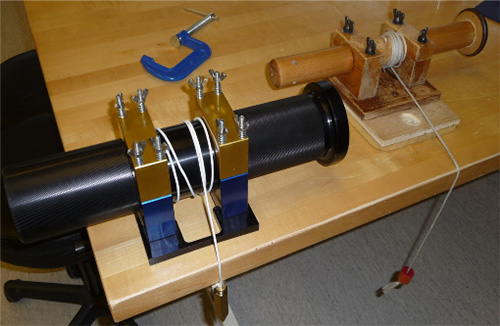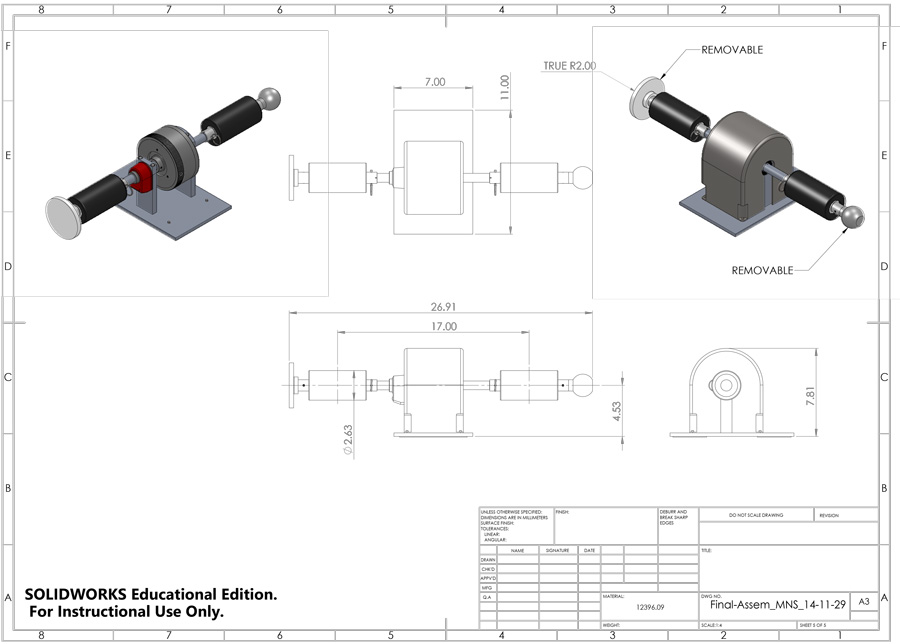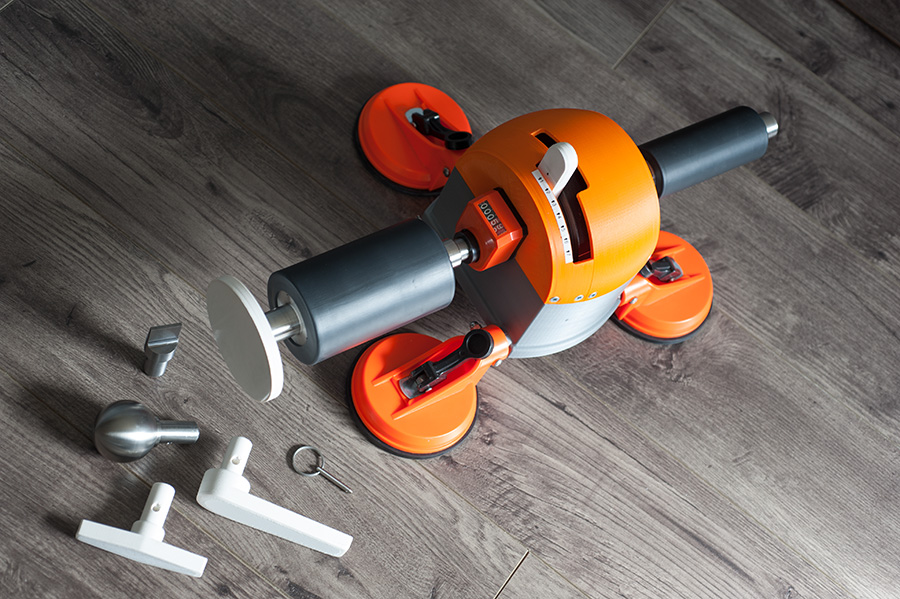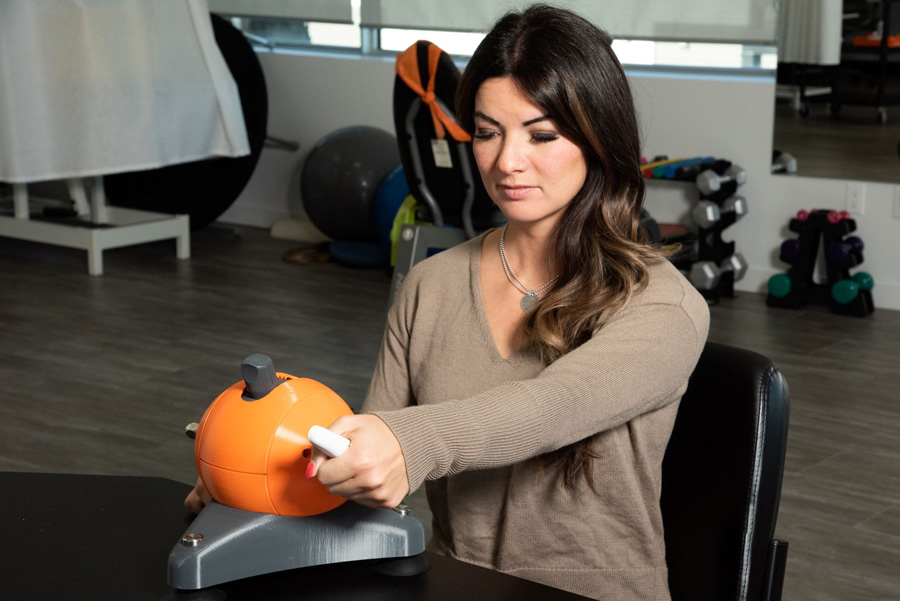FEPSim helps patients improve strength and flexibility in upper limbs, hands
Five years after handing in their final report, a NAIT student project is helping injured Albertans regain function in their hands, arms and shoulders at the country’s largest rehabilitation hospital.
The FEPSim is a rehabilitation device that allows patients to simulate daily activities such as turning a doorknob or using a screwdriver to strengthen muscles and improve flexibility. About 16 of the devices are being used at the Glenrose Rehabilitation Hospital and other facilities in Alberta for treating patients recovering from severe strokes, burns and muscle and bone injuries.
“We knew we had something special.”
“I think we knew we had something special because we could actually see the need and it was tangible,” says Brian Zizek, one of three former NAIT Bachelor of Technology students who took on the project as a capstone in 2016.
Zizek, now a graduate of the program (BTech ’15), and teammates Michelle Berg (BTech ’17, Personal Fitness Trainer ’06) and John Gushie (BTech ’16, Magnetic Resonance ’10) were tasked with working with therapists at the Glenrose to develop a prototype of the FEPSim. What they didn’t know at the beginning is how teaming up with another group of NAIT alumni would lead to the commercial product that is now poised to make a difference in hospitals around the world.
Solving a need for patient therapy
The FEPSim (which means flexion, extension, pronation and supination, in reference to the body movements it helps simulate) solved a long-standing need for patient rehabilitation exercises, says Michael Cimolini, Glenrose technology integration lead.
 The hospital had been using 30-year-old wooden devices made in-house for patient exercises. The MacGyvered tools were a problem for many reasons, including infection control because wood can’t be sterilized, and a lack of controls to fine-tune the amount of resistance.
The hospital had been using 30-year-old wooden devices made in-house for patient exercises. The MacGyvered tools were a problem for many reasons, including infection control because wood can’t be sterilized, and a lack of controls to fine-tune the amount of resistance.
“We had no idea how much resistance was being applied to it because you’re just sort of tightening down some wingnut,” Cimolini explains. “And there was nothing commercially available to replace it.”
“There was nothing commercially available to replace it.”
Two previous capstone projects by University of Alberta mechanical engineering students resulted in product designs but not a workable solution. The NAIT team was asked to combine the best ideas of both and develop a prototype that met the Glenrose’s needs.
Their backgrounds made them well suited to the job. Berg, the project manager who worked with the Glenrose to better understand their needs, had exercise and body mechanics experience through her personal trainer diploma. (What’s more, the facility was near to her heart, as her son was once a patient for a year-and-a-half to improve motor function and speech.)
 Zizek’s previous degree in mechanical engineering helped with refining product designs. Meanwhile Gushie, who worked remotely from the Yukon, had an understanding of anatomy through his background as an MRI technologist and took on writing duties.
Zizek’s previous degree in mechanical engineering helped with refining product designs. Meanwhile Gushie, who worked remotely from the Yukon, had an understanding of anatomy through his background as an MRI technologist and took on writing duties.
The group found a local 3D modeller who was willing – at no cost – to help bring the updated designs to life. They also approached three different machine shops in Edmonton for assistance in building the prototype, eventually landing on Karma Machining and Manufacturing, whose staff further refined the design.
The end result was a mishmash of auto parts and 3D printed pieces and other bits that were “Frankensteined” into a prototype, says Darryl Short (Mechanical Engineering Technology ’05, Machinist ’02), owner of Karma and president of Karmed, the company he later co-founded as a spinoff to manufacture and market FEPSim.
The FEPSim prototype was heavier than the team wanted and wasn’t pretty – Berg dubbed it “Marvin the Martian” for its resemblance to the Warner Bros. cartoon character’s helmet – but it was exactly what the Glenrose needed.
“It did all the functions that we wanted, gave us the control and all the range of motions that we wanted,” says Cimolini.

For the first time, Glenrose therapists could actually measure resistance and track a patient’s progress so they could improve rehabilitation plans.
“The team really pushed through – and in an phenomenal period of time.”
“The team really pushed through – and in an phenomenal period of time,” says Cimonlini of the students. “They did a phenomenal job.”
Serving a need on a global scale
The Karma team that worked on the prototype with the NAIT students thought they were done when the product was finished and the students presented their final report. Short says the Glenrose approached them about making further refinements, which led to several more versions.
Eventually, his wife and Karmed co-founder Melissa (Photographic Technology ’99) saw business potential, owing to her background as an occupational therapy assistant and familiarity with other rehabilitation tools. The only other comparable product was available exclusively in Asia, so they decided to make the FEPSim a separate business and Karmed was born.
“There’s a really, really big market for these devices,” Short says. “The rehab market is really in the Stone Ages. They’re like the black sheep of the family – forgotten in health care.”
The Glenrose agreed to sign over intellectual property rights for the invention to Karmed (NAIT industry partners retain IP), which soon filed a patent application. By investing in injection molding to create parts instead of 3D printing, they were able to cut plastic costs down from $1,500 per unit to about $50, Short says. The FEPSim now comes in vertical and horizontal versions and gives patients the ability to perform 75 different exercises.

Today, the device is also being used at the Royal Alex and Norwood hospitals in Edmonton and Foothills in Calgary.
“We’ve basically sold out of the first runs that we’ve done,” says Short. The company now has product demos in other cities in Canada, plus the United States, Australia and New Zealand.
Potential for more collaboration
Karmed envisions further improvements to incorporate data collection, biometrics and even gaming applications that Short says could result in new collaborations with NAIT and programs such as Electrical Engineering Technology and Digital Media and IT.
“There’s a lot of graduates that we could look at employing, the more successful we become,” Short says of Karmed, which in addition to Melissa also includes as co-founders Mike Claerhout (Hydrogeological Technology ’91, Plastics Engineering Technology ’93) and former NAIT Mechanical Engineering Technology instructor David deJong.
Although the capstone team is not involved in the business, the group hopes it succeeds, Zizek says. “That would be really cool to see.”
Zizek used his experience with FEPSim to develop a prototype for the Alberta government, including a hemp pilot project for InnoTech Alberta, which is an arm of Alberta Innovates. Berg is a program adviser with the Alberta School of Business, while Gushie is an MRI lead for Yukon hospitals.
“You need to be able to take somebody’s idea and make it real.”
Five years after completing the capstone, Berg is still proud of the many challenges they overcame.
“I’m glad that I was part of it. When it was hard, it was hard, but sometimes that’s the best way to learn – just getting in there and digging through it,” she says. “Capstones are good for that. You need to be able to take somebody’s idea and make it real.”
Banner image: Karmed